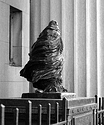archer
Member
- Joined
- Jun 29, 2009
- Messages
- 228
- Format
- 4x5 Format
Dear Grant;
the thought occurred to me to ask if you are using the same paper that you have always used? The reason for asking is that I once used a paper that was developer incorporated and the results were also mottled but only in the shadow areas. Have you changed papers lately? Also I never develop for less than 5min and my method for the troughs I use, is to take two 3in diameter, smoothly sanded PVC pipes, 38in long and place one in the trough and roll the paper around the other pipe and then into the developer. I then roll the print in the developer, onto the empty tube and when I reach the end I reverse the procedure and this continues for the 5min development time, then the print is held vertically to drain, then into the rinse tray and the same procedure takes place for 3min and then into the fix for 10min, using the same rolling procedure. This method results in many less damaged prints from creasing, denting and scratching and ensures very even development and makes it possible for one person to manage some very large prints. Needless to say your safelight illumination must be truly safe for the prolonged process.
Denise Libby
the thought occurred to me to ask if you are using the same paper that you have always used? The reason for asking is that I once used a paper that was developer incorporated and the results were also mottled but only in the shadow areas. Have you changed papers lately? Also I never develop for less than 5min and my method for the troughs I use, is to take two 3in diameter, smoothly sanded PVC pipes, 38in long and place one in the trough and roll the paper around the other pipe and then into the developer. I then roll the print in the developer, onto the empty tube and when I reach the end I reverse the procedure and this continues for the 5min development time, then the print is held vertically to drain, then into the rinse tray and the same procedure takes place for 3min and then into the fix for 10min, using the same rolling procedure. This method results in many less damaged prints from creasing, denting and scratching and ensures very even development and makes it possible for one person to manage some very large prints. Needless to say your safelight illumination must be truly safe for the prolonged process.
Denise Libby





